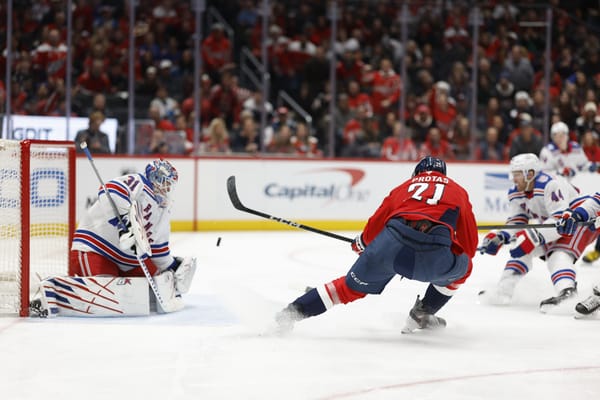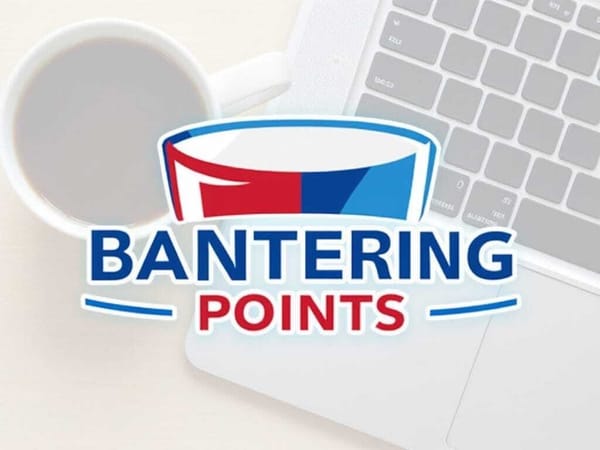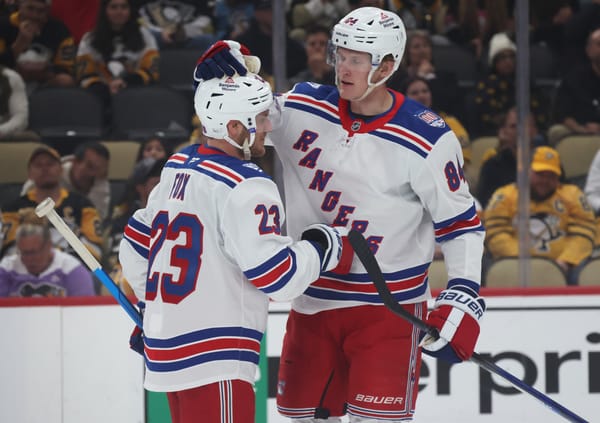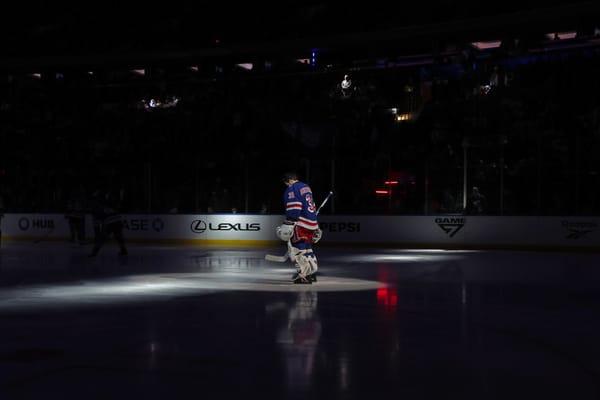Rick Nash Trade: Breaking It All Down
This trade was relatively massive, and had a lot of moving parts, so similar to what we did with the Michael Grabner trade, let’s break it all down here. (One note on Grabner: Adam also did a review with more detailed info on Yegor Rykov here.)
Rick Nash and retaining some of his salary
There are a few factors on this move, most of which we’ll break out in much more detail below, but the key aspect from the start was the salary issues for Boston. The Bruins couldn’t fit Nash under their cap naturally, so they needed to do some finagling. That turned into Gorton retaining 50% of his salary (which was always expected) and then taking a bad contract back in return. The Nick Holden addition probably didn’t help their cap needs, either.
So Gorton did what he should have done: He offered to take a bad contract back for more assets.
Here’s the thing: the market for rentals has been kind of soft this year. The Grabner return was good value, and on a lesser level so was the Holden return, but the higher end market has been soft. As of this writing (8:45 a.m. on Monday) there doesn’t seem to be an active market for Ryan McDonagh (this might change). Erik Karlsson seems to have a ton of buzz, but he’s also one of the best players on the planet. Evander Kane has had almost no interest, and he’s could be more of a long term play for an acquiring team. Gorton found a team that: A) wanted Nash badly, B) had quality assets they were willing to give back, and C) move him to a team that would put pressure on divisional rivals who also had interest in loading up with McDonagh.
Elliotte Friedman had speculated about the Rangers asking for Eli Tolvanen when Nashville was kicking the tires on Nash — which, of course Gorton should, always ask high — which then raised the expectation above sea level if you would. If you wanted a first round pick back (and it seems the Rangers did) then you’re not getting a top-flight prospect for a pure rental. The Rangers weren’t getting Tolvanen for Nash anyway. Instead, the Rangers smartly agreed to help Boston with their cap issue, and it got them three quality assets, and perhaps a fourth, for the price of one. This is a good move; you should be pleased with what Gorton did here.
Nash will be missed, of course. There’s a longer story coming on that aspect of things but he wasn’t going to help the Rangers this year and there’s still a chance he comes back to New York. Which would make this return even better.
Now, let’s break down said return.
The 1st Round Pick
Like I said in the Grabner piece, not all draft picks are created equal. I think a lot of people expected a player like Nash to bring back a 1st round pick (myself included), but this pick will probably be in the mid-to-late 20’s. That’s not a bad thing at all, but the value of a first round pick does drop significantly outside of the top five, then again outside the top 10 or 15 depending on the draft. This year’s draft is supposed to be very top heavy (read: strong top-seven or so) and then average, but I think people are saying that because there’s a dearth of centers and they move the needle more when it comes to pre-evaluating a draft. It’s filled with skilled wingers and defenseman, which the Rangers need. Having six picks in the first three rounds will help them load up on an organizational weakness: A lack of high-end talent on the wings and on defense. You can afford to take the boom or bust players when you have this many shots at it.
The first round pick was important, though, because even in the 20’s it has significantly more value than, say, where the Rangers will end up in the second round with the Devils’ pick. Getting this back for Nash was a must — but if no one was offering it then the Rangers needed to take what they could get. So Gorton getting this back was huge.
Ryan Spooner
Spooner is part of the “we have to give to get the Rangers to take salary” and I’m really intrigued with him as a player (and not just because he put up two assists in his Broadway debut).
The below is a little blurb from our friends over at the Stanley Cup of Chowder:
Spooner is a fantastic skater. He’ll routinely wow with his rushes up ice and the weird 10 to 2 shift his does with his skates. Not many players in the league move as well as he does. He’s good on the half-wall on the power play. Not an elite finisher, more of a set-up guy. If the Rangers can find a finisher who can match his speed, it could be a lot of fun. Not known as a three-zone player, but he’s improved along the wall and in the back-check this season. Goes quiet for extended stretches on occasion. Overall, a good playmaker with excellent speed.
I’ve done research on Spooner, and I’m a little torn on him. Adam argues that he’s a tweener: not a top six guy, but too good to be a bottom six guy. Those players tend to get term and value on their contracts, that hurts their team when they inevitably bottom out.
His numbers in Boston have combated that hypothesis. After his two-assist night again Detroit he now has 27 points in 40 games this year. Last year he only had 39 points in 78 games, but the year before that he had 49 in 80. In 253 NHL games he has 142 points — a 0.56 point-per-game ratio. As Cup of Chowder said above, he’s not an elite goal scorer, but he has fantastic vision and can make the passes you don’t think are possible. He reminds me of Mats Zuccarello (not a comparison to skill, just about his style of play). He uses his hands and speed to work space for himself, and at just 26-years-old you’d think he can continue that on a three-year deal or so.
The problem with saying his numbers prove Adam wrong is this: How much does the offensive support he got in Boston inflate those numbers?
I saw a lot of really good things from Spooner on the wing last night, especially on the power play. I think he’s a player worth the risk of keeping around if you can land him at a a two- or three-year deal for around $3-million, but there’s a catch to this: Spooner, J.T. Miller, and Kevin Hayes are all sort of the same player. All of them are RFAs at the end of this year, and the Rangers don’t need three of them on the roster. If the Rangers move Miller at the deadline or the draft (and of the three I think he can bring back the most value) then you lock down Spooner for the above (if you can do so cheaply) and keep Hayes (who I wouldn’t trade anyway for the reasons I outlined here). Keeping all three seems silly.
Ryan Lindgren
This was the prospect return for Nash, and to be honest I wasn’t thrilled with it at first blush. The problem about the Nash trade was the timing. When Bob announced the deal was done it was a 1st, Lindgren and the Rangers ate 50% of Nash’s cap. That would have been an underwhelming return since Lindgren isn’t even really in the second tier of prospects for the Bruins.
The more research I did on him, though, the more I see where the Rangers are going with this. His college numbers are awful (14 points in 65 games) and his World Junior numbers (two assists in 14 games) are worse. Again, on paper.
But that’s not the story with Lindgren. He’s not a puck-moving defenseman, he’s a defensive defenseman. For Minnesota he plays their toughest minutes (as the coach said, the “heavy minutes”), is tasked with shutting down the other team’s top players, and was voted a captain as a sophomore (a rarity in Minnesota that speaks volumes). He has leadership qualities up the wazoo, and is a good skater to along with his work in the tougher areas of the ice. He’s also a big body who can, and will, throw his weight around. As seen here:
Gophers D Ryan Lindgren (BOS) absolutely wrecks Michigan's Nick Pastujov with a huge check, even Pastujov was impressed pic.twitter.com/3aI0a3XPaV
— CJ Fogler (@cjzero) January 14, 2018
Here’s a little blurb on him from Stanley Cup of Chowder:
Had a pretty good WJC and has been steady in college. Not an elite speedster or puck-mover, but a steady blue line presence. One of those guys who can be hard to notice in a game, but in a good way, because he’s a defenseman. Not going to wow anyone with his shot or speed, but plays a smart game. Has been known to throw a big hit on occasion, like the one he laid against Michigan. Will be interesting to watch him develop. He has decent tools, but is probably still a year or two away from turning pro.
To be clear: This isn’t Dylan McIlrath 2.0. Lindgren is a good skater, and his hockey IQ seems to be in the right place. He has to develop further before he makes it to the NHL, but he’s got a lot of things to like about him so long as your expectations are reasonable.
Adam will have more on him later, but from what I’ve been able to see/project myself, his ceiling is probably a #4 defenseman, with him much more likely being a solid presence on the third pair. Not exactly the type of prospect return for a guy like Nash, but there’s other aspects to this trade (as seen above) that kept the prospect in the lower pool of Boston’s assets. Yegor Rykov has a much higher ceiling, for what it’s worth.
That said, smart, good skating defenseman who can throw their weight around and are leaders in the room aren’t bad guys to have. Prospects are lottery tickets after all. The more you have, the more chances to hit big.
Matt Belesky (50% salary retained by Boston)
The parentheses above are critical here. Belesky is well known for having one really good year, then signing a massive contract with Boston worth $3.8-million per, not living up to that contract, and now plying his trade in the AHL. He was the bad contract that came back to make things work for the Bruins in terms of salary.
With Boston eating half of his salary, the Rangers’ cap hit from Belesky is $1.9-million. When buried in the AHL (as he is now) that cap hit reduces down to $875K. That’s nothing.
Belesky can also be a very good fourth line option, if given the opportunity. At $1.9-million he would be expensive, but he’s got two years left on his deal and there’s still a debate over how competitive the Rangers expect to be next year. If they decide they need the money, they can bury him in the AHL or buy him out (buying him out actually costs more cap that burying him). If he earns a role on the fourth line, he could be a good option there; if not, the $900K cap hit won’t move the needle.
Overall, I think this is really good value for Nash, especially if he comes back to Broadway this summer.





